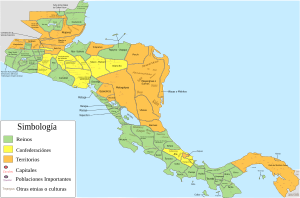Nicarao (cacique) facts for kids
Nicarao was a powerful leader, also known as a cacique, of an indigenous tribe in what is now southwestern Nicaragua. He lived in the early 1500s. Historians later found out in 2002 that his real name was Macuilmiquiztli.
Contents
First European Contact
Christopher Columbus explored the eastern coast of Nicaragua in 1502. This was his fourth and last trip to the Americas. However, he did not travel to the western coast of Nicaragua. He also did not meet any of the local tribes there.
In 1522, a Spanish explorer named Gil González Dávila arrived. He traveled from Panama with 100 men. This was the first time Europeans explored the western parts of Costa Rica and Nicaragua.
Meeting the Tribe
When González Dávila and his men reached southwestern Nicaragua, they met a tribe. These people spoke a language called Nahuat. González Dávila had two indigenous interpreters with him. These interpreters helped him talk with the tribe's leader. This leader has been known as Nicarao ever since.

Nicarao's Territory
Nicarao ruled over a large area called a cacicazgo. This land was located in the Rivas Department of Nicaragua. It was right next to Lake Nicaragua. His territory also stretched south into what is now the Guanacaste Province in northwestern Costa Rica.
The Capital City
The main city or settlement of Nicarao's tribe was called Quauhcapolca. Some history books have also called it Nicaraocallí. Experts believe this city was near the modern lake port of San Jorge.
How Nicaragua Got Its Name
For a long time, people believed the name "Nicaragua" came from Nicarao. A popular idea was that it combined Nicarao's name with the Spanish word agua, which means "water." This made sense because Nicaragua has two large lakes and many other bodies of water.
See also
 In Spanish: Nicarao para niños
In Spanish: Nicarao para niños

